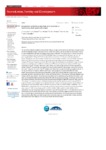Por favor, use este identificador para citar o enlazar este ítem:
http://www.alice.cnptia.embrapa.br/alice/handle/doc/966395Registro completo de metadatos
| Campo DC | Valor | Lengua/Idioma |
|---|---|---|
| dc.contributor.author | LIMA, J. T. M. | pt_BR |
| dc.contributor.author | FONSECA, J. F. da | pt_BR |
| dc.contributor.author | ESTEVES, L. V. | pt_BR |
| dc.contributor.author | PENEIRAS, A. B. V. | pt_BR |
| dc.contributor.author | LIMA, M. S. D. | pt_BR |
| dc.contributor.author | BRANDÃO, F. Z. | pt_BR |
| dc.date.accessioned | 2013-09-17T11:11:11Z | pt_BR |
| dc.date.available | 2013-09-17T11:11:11Z | pt_BR |
| dc.date.created | 2013-09-17 | pt_BR |
| dc.date.issued | 2013 | pt_BR |
| dc.identifier.citation | Reproduction, Fertility and Development, v. 25, n. 1, p. 151, 2013. | pt_BR |
| dc.identifier.uri | http://www.alice.cnptia.embrapa.br/alice/handle/doc/966395 | pt_BR |
| dc.description | Abstract: The aim of this study was to determine the intervals between sponge removal and the onset of estrus, sponge removal and the first detected ovulation, and onset of estrus and the first ovulation, and also to determine the duration of estrus, in superovulated Santa Inês ewes subjected to natural mating (NM) and AI. The trial was done in July and February at Cachoeiras de Macacu?Rio de Janeiro (22°27'S, 43°39'W). Fifteen non-pregnant Santa Inês ewes, age 3.4 ± 1.4 years, weighing 47.8 ± 6.3 kg, with 3.3 ± 0.4 body condition score (scale of 1 to 5), were randomly assigned to 2 groups. Both groups were superovulated using the same protocol and were mated in a crossover design by NM and laparoscopic AI. Estrus was synchronized using intravaginal sponges (60 mg of medroxyprogesterone acetate; Progespon®, Schering Plough Animal Health, São Paulo, Brazil) inserted (Day 0) and maintained for 6 days. On Day 5, the ewes received IM injections of 300 IU of eCG (Novormon®, Schering Plough Animal Health) and 0.0375 mg of cloprostenol (Prolise®, Tecnopec, São Paulo, Brazil). Twelve hours after sponge removal, 0.025 mg of gonadorelin acetate (Gestran®, Tecnopec) was administered IM. Superovulation started 60 h after sponge removal and consisted of 5 IU kg -1 of porcine FSH (pFSH; Pluset®, Hertape Calier, Minas Gerais, Brazil) IM in 6 decreasing doses (25, 25, 15, 15, 10, and 10%) at 12-h intervals. At the first pFSH dose, new sponges were inserted. At the fifth pFSH dose, 0.0375 mg of cloprostenol was administered IM and the sponges were removed. After the sponge removal, the NM group was exposed to rams twice per day for mating, until the end of estrus. In the AI group, estrus was detected using a teaser with the penis diverted. The females were permitted to be mounted twice per day until the end of estrus, and were inseminated with frozen-thawed semen 24 and 36 h after the end of superovulation. The follicular development and ovulation time were observed using real-time ultrasonography (8.0 MHz Pie Medical®, Aquila Vet, Tokyo, Japan) at 12-h intervals. For statistical analysis, a Student's t-test was performed (5% significance level) using the BioEstat program. Results are presented as mean ± standard deviation. The time from sponge removal to onset of estrus and the duration of estrus did not differ between NM and AI groups (31.79 ± 5.94 v. 25.25 ± 10.38 h and 29.89 ± 11.54 v. 26.66 ± 8.67 h, respectively). The time from sponge removal to ovulation and from onset of estrus to the first ovulation were shorter (P < 0.001) in the NM group (32.11 ± 12.72 v. 56.48 ± 15.39 h and 8.61 ± 5.99 v. 32.25 ± 18.57 h, respectively). The time from sponge removal to ovulation in July and February was 56.07 ± 7.27 versus 56.83 ± 20.72 in the AI group and 29.54 ± 0.56 versus 33.83 ± 19.02 in the NM group, respectively, suggesting that the season of the year in a tropical region did not influence the ovulation time for each treatment. Possibly, the mechanical stimulation induced by the contact of the penis with the vagina fornix and by the accessory sex glands fluids in mating hastened the ovulation time in the NM group. The service can shorten the time of ovulation. | pt_BR |
| dc.language.iso | eng | eng |
| dc.rights | openAccess | eng |
| dc.subject | Raça Santa Inês | pt_BR |
| dc.subject | Oestrus synchronization | pt_BR |
| dc.subject | Superovulated females | pt_BR |
| dc.title | Duration of estrus and time of ovulation in superovulated Santa Inês ewes. | pt_BR |
| dc.type | Resumo em anais e proceedings | pt_BR |
| dc.date.updated | 2015-04-08T11:11:11Z | pt_BR |
| dc.subject.thesagro | Ovino | pt_BR |
| dc.subject.thesagro | Ovelha | pt_BR |
| dc.subject.thesagro | Superovulação | pt_BR |
| dc.subject.thesagro | Ovulação | pt_BR |
| dc.subject.thesagro | Ciclo estral | pt_BR |
| dc.subject.thesagro | Reprodução animal | pt_BR |
| dc.subject.nalthesaurus | Sheep | pt_BR |
| dc.subject.nalthesaurus | Ovulation | pt_BR |
| dc.subject.nalthesaurus | Reproduction | pt_BR |
| dc.subject.nalthesaurus | Superovulation | pt_BR |
| riaa.ainfo.id | 966395 | pt_BR |
| riaa.ainfo.lastupdate | 2015-04-08 | pt_BR |
| dc.identifier.doi | http://dx.doi.org/10.1071/RDv25n1Ab8 | pt_BR |
| dc.contributor.institution | J. T. M. Lima, Fluminense Federal University, Niterói, Rio de Janeiro, Brazil; JEFERSON FERREIRA DA FONSECA, CNPC; L. V. Esteves, Fluminense Federal University - Niterói, Rio de Janeiro, Brazil; A. B. V. Peneiras, Fluminense Federal University - Niterói, Rio de Janeiro, Brazil; M. S. D. Lima, Fluminense Federal University - Niterói, Rio de Janeiro, Brazil; F. Z. Brandão, Fluminense Federal University - Niterói, Rio de Janeiro, Brazil. | pt_BR |
| Aparece en las colecciones: | Resumo em anais de congresso (CNPC)  | |
Ficheros en este ítem:
| Fichero | Descripción | Tamaño | Formato | |
|---|---|---|---|---|
| racDurationofestrus.pdf | 255,82 kB | Adobe PDF |  Visualizar/Abrir |









